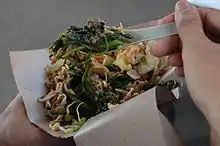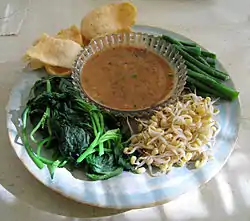Pecel
Pecel (Indonesian pronunciation: [pət͡ʃəl]), (Javanese:ꦥꦼꦕꦼꦭ꧀) is a traditional Indonesian - Javanese salad, consisting of mixed vegetables in a peanut sauce dressing,[1] usually served with steamed rice, or lontong or ketupat compressed rice cakes.[2][3]
 | |
| Alternative names | Pecal |
|---|---|
| Place of origin | Indonesia |
| Region or state | Yogyakarta, Central Java, East Java |
| Serving temperature | Room temperature |
| Main ingredients | Vegetables in peanut sauce |
The peanut sauce used in pecel is quite similar to those used in gado-gado, a similar Indonesian traditional salad with slightly different ingredients. Peanut sauce for pecel, however, contains no coconut milk.[2] Pecel has been strongly associated with Javanese cuisine, while gado-gado is usually associated with Betawi and Sundanese cuisine.
Pecel can be homemade, but it is often sold in Javanese restaurants or in warung. It is also sold by Mbok bakul pecel, travelling pecel-selling women that carry pecel ingredients in woven bamboo baskets and frequent residential areas, marketplaces, or train stations to sell their wares. This travelling sales method is similar to Mbok jamu gendong, a method of selling jamu (a traditional medicine).
The simplicity of pecel preparation and its cheap price have contributed to its popularity throughout Java. It has become a food that represents practicality, simplicity, and travel, since the dish is often found along the train journey across Java.[4]
Pecel was introduced to Malaysia, where it is known as pecal,[5] by Javanese immigrants. Pecel is also very popular in Suriname, where it was introduced by the Javanese Surinamese.
History
Pecel comes from Java, but its exact origin is unknown. Vegetables smeared in sauce have been eaten in Java for centuries. Ary Budiyanto, an anthropologist of Brawijaya University in Malang, East Java, suggests that ancient texts used the term "pecel" to refer to food preparation by slathering or smearing a substance over the main ingredient.[1] Later, the term came to refer to a type of dish of vegetables with sauce.[1] The term "pecel" was mentioned in the manuscript of Sanghyang Siksakanda Ng Karesian, which was written in 1518, and was defined as a sauce served with chicken. Today, pecel sauce can be served with lawar (raw vegetables) or kuluban (cooked vegetables).
"Pecel" is also mentioned in Babad Tanah Jawi, composed around the 17th or 18th centuries, which suggest that the Javanese word "pecel" refers to the action of squeezing, since the boiled or blanched vegetables were squeezed by hand to separate them from the water.[6]
Ingredients
Pecel consists of boiled or blanched water spinach, chinese amaranth, bean sprouts, yardlong bean, cucumber, cassava leaf, and lemon basil, served with a sauce made from ground fried peanuts mixed with water, salt, palm sugar, tamarind juice, chili pepper, galangal, kaffir lime leaf, and garlic. Additional side dishes can be served with a pecel dish, such as fried tempeh or tofu, perkedel kentang, bakwan jagung (vegetables and corn fritters), crispy rempeyek peanut crackers, or krupuk.
Variants

The vegetables used in pecel vary, and the peanut sauce's recipe differs slightly between different regions in Java. Different pecel recipes can have different amounts of Kaffir lime leaf zest, galangal, palm sugar, or tamarind juice, leading to different flavors.
In Yogyakarta, pecel is served with bacem (sweet-simmered) tempeh or tofu, while in Solo and Madiun, it is served with krupuk karak rice crackers.[4]
Today, pecel is often associated with Madiun[7] and Ponorogo in East Java, since they have the most famous pecel variant, and also because sate Ponorogo uses the same kind of peanut sauce that is normally used in pecel. Nevertheless, pecel can now be found in most Javanese villages and cities.
See also
References
- Putra AW, Nedi (24 October 2019). "Digging into the history of 'pecel'". The Jakarta Post. Retrieved 2019-10-24.
- Pecel Recipe (Java Style Salad with Peanut Sambal)
- Vegetable Salad with Peanut Sauce, Pecel Archived 2015-01-19 at the Wayback Machine
- Agmasari, Silvita. "Asal Usul Pecel, Makanan untuk Semua Kalangan yang Kaya Gizi". KOMPAS.com (in Indonesian). Retrieved 2019-10-24.
- "Buffet features favourite dishes of Malaysia's first four prime ministers". The Star (Malaysia). 31 July 2013. Archived from the original on 26 September 2013. Retrieved 26 August 2013.
- "Sejarah Pecel Diceritakan dalam Babat Tanah Jawi, Jadi Simbol Perjalanan dan Kesederhanaan". Tribun Travel (in Indonesian). Retrieved 2019-10-24.
- "Pecel 99 Madiun Digandrungi Artis hingga Presiden". KOMPAS.com (in Indonesian). Retrieved 2019-10-24.
